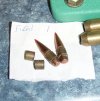Bigeclipse
Well-Known Member
- Joined
- Aug 10, 2012
- Messages
- 1,967
From what I have read, bullet weld can happen to ammo which sits for a long time. I'm not new to reloading or shooting but when it comes to bullet weld I have read a lot of conflicting info so I have a few questions as follows:
1. Does it only cause inconsistencies or can it actually be dangerous?
2. I have read neck lubing can help prevent this (graphite as an example). Does it PREVENT it completely or can it still occur?
3. How many rounds and for how long do you keep loaded for your hunting rigs? Reason I ask is I like to have a minimum of 20 rounds going into a hunting season. This gives me some sighters to make sure my rifle is on and then 10 or more for actually hunting. I typically do not have reloads sitting around longer than 6 months and most often only a couple months but I do have some backup rifles for hunting which may not get shot for years. I like to keep rounds loaded but not if bullet weld is possible.
1. Does it only cause inconsistencies or can it actually be dangerous?
2. I have read neck lubing can help prevent this (graphite as an example). Does it PREVENT it completely or can it still occur?
3. How many rounds and for how long do you keep loaded for your hunting rigs? Reason I ask is I like to have a minimum of 20 rounds going into a hunting season. This gives me some sighters to make sure my rifle is on and then 10 or more for actually hunting. I typically do not have reloads sitting around longer than 6 months and most often only a couple months but I do have some backup rifles for hunting which may not get shot for years. I like to keep rounds loaded but not if bullet weld is possible.

